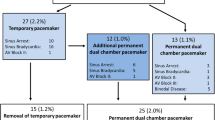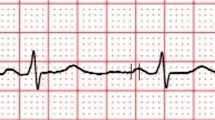Abstract
Purpose
This study aimed to assess pulmonary vein isolation (PVI) efficacy on atrial fibrillation (AF) recurrence and to determine a predictive dispersion of atrial refractoriness (dERP) value for performing PVI in paroxysmal supraventricular tachycardia (PSVT) patients.
Methods
Of 67 PSVT patients with past AF episodes who underwent accessory pathway (AP) or slow pathway of atrioventricular node ablation, 63 (4 lost to follow-up or death) were assigned into two groups (A and B; 29 and 34 patients, respectively) based on whether they underwent or not subsequent PVI, and all were followed-up up to 3 years. Atrial effective refractory period (AERP) and dERP were measured during the ablation procedure.
Results
In receiver operating characteristic (ROC) curve analysis, dERP = 74.5 ms effectively predicted AF recurrence in PSVT patients (p = 0.003). Difference in AF recurrence rate between groups did not reach statistical significance (17.2 %, 5/29 vs. 29.4 %, 10/34, p = 0.203). AF recurrence rate was lower in patients with dERP >74.5 ms who underwent AP or slow-pathway ablation with vs. without PVI (18.2 %, 2/11 vs. 77.8 %, 7/9, p = 0.012).
Conclusions
PVI addition after successful AP or slow pathway of atrioventricular node ablation significantly reduced AF recurrence in PSVT patients with high atrial vulnerability (dERP >74.5 ms).

Similar content being viewed by others
References
Centurión, O. A., Shimizu, A., Isomoto, S., & Konoe, A. (2008). Mechanisms for the genesis of paroxysmal atrial fibrillation in the Wolff–Parkinson–White syndrome: intrinsic atrial muscle vulnerability vs. electrophysiological properties of the accessory pathway. Europace, 10, 294–302.
Amasyali, B., Kose, S., Aytemir, K., Kilic, A., Heper, G., Kursaklioglu, H., Iyisoy, A., Celik, T., Kaya, E. B., & Isik, E. (2005). Atrioventricular nodal reentrant tachycardia with paroxysmal atrial fibrillation: clinical and electrophysiological features and predictors of atrial fibrillation recurrence following elimination of atrioventricular nodal reentrant tachycardia. Journal of Interventional Cardiac Electrophysiology, 13, 195–201.
Cappato, R., Calkins, H., Chen, S. A., Davies, W., Iesaka, Y., Kalman, J., Kim, Y. H., Klein, G., Packer, D., & Skanes, A. (2005). Worldwide survey on the methods, efficacy, and safety of catheter ablation for human atrial fibrillation. Circulation, 111, 1100–1105.
Nattel, S., Li, D., & Yue, L. (2000). Basic mechanisms of atrial fibrillation—very new insights into very old ideas. Annual Review of Physiology, 62, 51–57.
Zhen, L., Hertervig, E., Carlson, J., Camilla, J., Bertil, O., & Yuan, S. (2002). Dispersion of refractoriness in patients with paroxysmal atrial fibrillation. Evaluation with simultaneous endocardial recordings from both atria. Journal of Electrocardiology, 35, 227–234.
Oliveira, M., da Silva, M. N., Timoteo, A. T., Feliciano, J., Sousa, L., Santos, S., Silva-Carvalho, L., & Ferreira, R. (2009). Inducibility of atrial fibrillation during electrophysiologic evaluation is associated with increased dispersion of atrial refractoriness. International Journal of Cardiology, 136, 130–135.
Tsuji, H., Fujiki, A., Tani, M., Yoshida, S., & Sasayama, S. (1992). Quantitative relationship between atrial refractoriness and the dispersion of refractoriness in atrial vulnerability. Pacing and Clinical Electrophysiology, 15, 403–410.
Riccardi, R., Gaita, F., Giustetto, C., & Gardiol, S. (1997). Atrial electrophysiological features in patients with Wolff–Parkinson–White and atrial fibrillation: absence of rate adaptation of intraatrial conduction time parameters. Pacing and Clinical Electrophysiology, 20, 1318–1327.
Liao, Z., Chang, Y., Ma, J., Fang, P., Zhang, K., Ren, X., Yang, P., Yu, B., Hu, J., Yang, Q., Ouyang, F., & Zhang, S. (2012). Atrioventricular node reentrant tachycardia in patients with congenitally corrected transposition of the great arteries and results of radiofrequency catheter ablation. Circulation. Arrhythmia and Electrophysiology, 5, 1143–1148.
Huang, J. L., Chen, S. A., Tai, C. T., Chiang, C. E., Lee, S. H., Chiou, C. W., Ueng, K. C., Wen, Z. C., Yu, W. C., Chen, Y. J., & Chang, M. S. (1996). Long-term results of radiofrequency catheter ablation in patients with multiple accessory pathways. American Journal of Cardiology, 78, 1375–1379.
Liu, X., Tan, H. W., Wang, X. H., Shi, H. F., Li, Y. Z., Li, F., Zhou, L., & Gu, J. N. (2010). Efficacy of catheter ablation and surgical CryoMaze procedure in patients with long-lasting persistent atrial fibrillation and rheumatic heart disease: a randomized trial. European Heart Journal, 31, 2633–2641.
Kumar, S., Morton, J. B., Lee, J., Halloran, K., Spence, S. J., Gorelik, A., Hepworth, G., Kistler, P. M., & Kalman, J. M. (2012). Prospective characterization of catheter–tissue contact force at different anatomic sites during antral pulmonary vein isolation. Circulation. Arrhythmia and Electrophysiology, 5, 1124–1129.
Deneke T, Mügge A; Atrial fibrillation and Wolff–Parkinson–White syndrome: mechanisms revisited? J Cardiovasc Electrophysiol. 23, 287–289.
Chang, S. L., Tai, C. T., Lin, Y. J., Lo, L. W., Tuan, T. C., Udyavar, A. R., Tsao, H. M., Hsieh, M. H., Hu, Y. F., Chiang, S. J., Chen, Y. J., Wongcharoen, W., Ueng, K. C., & Chen, S. A. (2008). Electrophysiological characteristics and catheter ablation in patients with paroxysmal supraventricular tachycardia and paroxysmal atrial fibrillation. Journal of Cardiovascular Electrophysiology, 19, 367–373.
Fujimura, O., Klein, G. J., Yee, R., & Sharma, A. D. (1990). Mode of onset of atrial fibrillation in the Wolff-Parkinson-White syndrome: how important is the accessory pathway? Journal of the American College of Cardiology, 15, 1082–1086.
Chen, Y.-J., Chen, S.-A., Tai, C. T., Wen, Z.-C., Feng, A.-N., Ding, Y.-A., & Chang, M.-S. (1998). Role of atrial electrophysiology and autonomic nervous system in patients with supraventricular tachycardia and paroxysmal atrial fibrillation. Journal of the American College of Cardiology, 32, 732–738.
Sakabe, K., Fukuda, N., Fukuda, Y., Morishita, S., Shinohara, H., & Tamura, Y. (2010). Relation of gender and interatrial dyssynchrony on tissue Doppler imaging to the prediction of the progression to chronic atrial fibrillation in patients with nonvalvular paroxysmal atrial fibrillation. Heart and Vessels, 25, 410–416.
Dagres, N., Clague, J. R., Kottkamp, H., Hindricks, G., Breithardt, G., & Borggrefe, M. (2001). Impact of radiofrequency catheter ablation of accessory pathways on the frequency of atrial fibrillation during long-term follow-up. High recurrence rate of atrial fibrillation in patients older than 50 years of age. European Heart Journal, 22, 423–427.
Morillo, C. A., Klein, G. J., Jones, D. L., & Guiraudon, C. M. (1995). Chronic rapid atrial pacing. Structural, functional, and electrophysiological characteristics of a new model of sustained atrial fibrillation. Circulation, 91, 1588–1595.
Bosch, R. F., Zeng, X., Grammer, J. B., Popovic, K., Mewis, C., & Kühlkamp, V. (1999). Ionic mechanisms of electrical remodeling in human atrial fibrillation. Cardiovascular Research, 44, 121–131.
Pang, H., Ronderos, R., Pérez-Riera, A. R., Femenía, F., & Baranchuk, A. (2011). Reverse atrial electrical remodeling: a systematic review. Cardiology Journal, 18, 625–631.
Rostock, T., Steven, D., Lutomsky, B., Servatius, H., Drewitz, I., Klemm, H., Müllerleile, K., Ventura, R., Meinertz, T., & Willems, S. (2008). Atrial fibrillation begets atrial fibrillation in the pulmonary veins on the impact of atrial fibrillation on the electrophysiological properties of the pulmonary veins in humans. Journal of the American College of Cardiology, 51, 2153–2160.
Jaïs, P., Hocini, M., Macle, L., Choi, K. J., Deisenhofer, I., Weerasooriya, R., Shah, D. C., Garrigue, S., Raybaud, F., Scavee, C., Le Metayer, P., Clémenty, J., & Haïssaguerre, M. (2003). Distinctive electrophysiological properties of pulmonary veins in patients with atrial fibrillation. Circulation, 106, 2476–2485.
Derejko, P., Szumowski, L. J., Sanders, P., Krupa, W., Bodalski, R., Orczykowski, M., Urbanek, P., Zakrzewska, J., Lim, H. S., Lau, D. H., Kuśnierz, J., & Walczak, F. (2012). Atrial fibrillation in patients with Wolff–Parkinson–White syndrome: role of pulmonary veins. Journal of Cardiovascular Electrophysiology, 23, 280–286.
Pappone, C., Rosanio, S., Oreto, G., Tocchi, M., Gugliotta, F., Vicedomini, G., Salvati, A., Dicandia, C., Mazzone, P., Santinelli, V., Gulletta, S., & Chierchia, S. (2000). Circumferential radiofrequency ablation of pulmonary vein ostia: a new anatomic approach for curing atrial fibrillation. Circulation, 102, 2619–2628.
Ouyang, F., Bänsch, D., Ernst, S., Schaumann, A., Hachiya, H., Chen, M., Chun, J., Falk, P., Khanedani, A., Antz, M., & Kuck, K. H. (2004). Complete isolation of left atrium surrounding the pulmonary veins: new insights from the double-Lasso technique in paroxysmal atrial fibrillation. Circulation, 110, 2090–2096.
Palma, E. C., Ferrick, K. J., Gross, J. N., Kim, S. G., & Fisher, J. D. (2000). Transition from atrioventricular node reentry tachycardia to atrial fibrillation begins in the pulmonary veins. Circulation, 102(8), 102–937.
Sauer, W. H., Alonso, C., Zado, E., Cooper, J. M., Lin, D., Dixit, S., Russo, A., Verdino, R., Ji, S., Gerstenfeld, E. P., Callans, D. J., & Marchlinski, F. E. (2006). Atrioventricular nodal reentrant tachycardia in patients referred for atrial fibrillation ablation response to ablation that incorporates slow-pathway modification. Circulation, 114, 191–195.
Acknowledgments
This study was sponsored by the Natural Science Foundation of China (81270238) and the Scientific Research Foundation for Doctoral Degree, State Education Ministry of China (20130131110065).
Conflict of interest
None.
Author information
Authors and Affiliations
Corresponding author
Rights and permissions
About this article
Cite this article
Xu, Zx., Zhong, Jq., Rong, B. et al. Effect of pulmonary vein isolation on atrial fibrillation recurrence after ablation of paroxysmal supraventricular tachycardia in patients with high dispersion of atrial refractoriness. J Interv Card Electrophysiol 41, 169–175 (2014). https://doi.org/10.1007/s10840-014-9937-4
Received:
Accepted:
Published:
Issue Date:
DOI: https://doi.org/10.1007/s10840-014-9937-4




